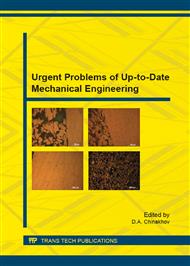[1]
A. A Zakharova, E.V. Telipenko, Information system of bankruptcy risk management of an enterprise, J. Proceedings 7th International Forum on Strategic Technology, IFOST 2012, 1 (2012) 539-543.
DOI: 10.1109/ifost.2012.6357615
Google Scholar
[2]
A. Grigoreva, Information system of innovative products competitiveness determining. J. Proceedings 7th International Forum on Strategic Technology, IFOST 2012. 1 (2012) 691-694.
DOI: 10.1109/ifost.2012.6357651
Google Scholar
[3]
T.Y. Chernysheva, Information systems project risk assessment: expert approach, J. Applied Mechanics and Materials, 682 (2014) 539-543.
DOI: 10.4028/www.scientific.net/amm.682.539
Google Scholar
[4]
E.V. Telipenko, A.A. Zakharova Bankruptcy Risk Management of a Machine Builder, J. Applied Mechanics and Materials, 682 (2014) 617-622.
DOI: 10.4028/www.scientific.net/amm.682.617
Google Scholar
[5]
A. Tceplit, A. Grigoreva, Y. Osipov, Developing the Model for Assessing the Competitiveness of Innovative Engineering Products, J. Applied Mechanics and Materials. 682 (2014) 623-630.
DOI: 10.4028/www.scientific.net/amm.682.623
Google Scholar
[6]
T.Y. Chernysheva Preliminary risk assessment in it projects, J. Applied Mechanics and Materials. 379 (2013) 220-223.
DOI: 10.4028/www.scientific.net/amm.379.220
Google Scholar
[7]
S.V. Razumnikov, A.A. Zakharova, M.S. Kremneva, A Model of Decision Support on Migration of Enterprise IT-Applications in the Cloud Environment, J. Applied Mechanics and Materials . 682 (2014) 600-605.
DOI: 10.4028/www.scientific.net/amm.682.600
Google Scholar
[8]
D. Leigh, Chapter 5. SWOT Analysis, in: Handbook of Improving Performance in the Workplace, J. John Wiley & Sons, Ltd. 2 (2009) 115–140.
Google Scholar
[9]
G. Panagiotou, Bringing SWOT into focus, Business Strategy Review. 14 (2) (2003) 8–10.
DOI: 10.1111/1467-8616.00253
Google Scholar
[10]
W. Edwards Deming, The New Economics for Industry, Government, Education, 2nd ed., MIT Press, (2000).
Google Scholar
[11]
A.A. Zakharova, Fuzzy swot analysis for selection of bankruptcy risk factors, J. Applied Mechanics and Materials. 379 (2013) 207-213.
DOI: 10.4028/www.scientific.net/amm.379.207
Google Scholar
[12]
N. Bhushan, and K. Ria, Strategic Decision Making: Applying the Analytic Hierarchy Process, London: Springer-Verlag London Limited, (2004).
Google Scholar
[13]
T.L. Saaty, The Analytic Hierarchy Process, New York: McGraw Hill. International, Translated to Russian, Portuguese, and Chinese, Revised editions, Paperback (1996, 2000), Pittsburgh: RWS Publications.
Google Scholar
[14]
J. Ramik Fuzzy goals and fuzzy alternatives in goal programming problems, J. Fuzzy sets and systems, V. III. (2000) 81-86.
DOI: 10.1016/s0165-0114(98)00454-0
Google Scholar
[15]
A.A. Zakharova, E.V. Telipenko, Integral evaluation index of an enterprise bankruptcy risk management strategy evaluation, J. Proceedings of Tomsk State University of Control Systems and Radioelectronics, 3 (2013) 152-15.
Google Scholar


